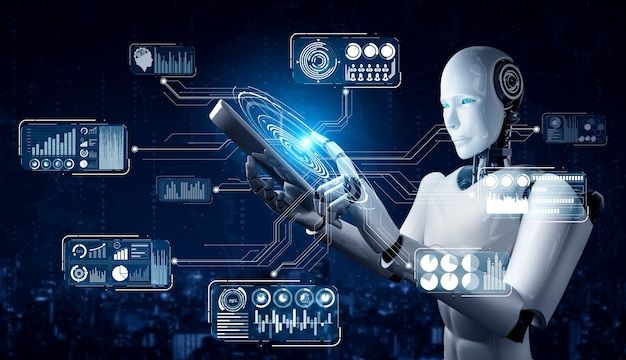How Machine Learning is Revolutionizing Industries
|
Getting your Trinity Audio player ready...
|
Machine learning (ML), a subset of artificial intelligence (AI), has become a driving force behind innovations across various industries. By enabling machines to learn from data, identify patterns, and make decisions with minimal human intervention, ML is reshaping how businesses operate, improving efficiency, and driving new revenue streams. This article explores the ways in which machine learning is transforming industries, offering unprecedented opportunities for growth and innovation.
1. Healthcare: Improving Diagnosis and Treatment
Machine learning is revolutionizing healthcare by improving the accuracy and speed of medical diagnosis, predicting disease outbreaks, and personalizing treatment plans. With the ability to analyze vast amounts of data, ML algorithms can detect patterns that may be missed by human eyes, helping in the early diagnosis of diseases like cancer and diabetes.
Examples:
- AI-powered imaging tools can analyze radiology images to detect abnormalities like tumors at a much faster and more accurate rate than traditional methods.
- Predictive analytics models are used to predict patient outcomes, optimize treatment plans, and manage hospital resources efficiently.
- Personalized medicine uses ML to analyze genetic data and lifestyle factors, creating customized treatment plans for individual patients.
2. Finance: Fraud Detection and Algorithmic Trading
In the financial industry, machine learning is used to detect fraudulent transactions, automate trading, and manage risks. ML algorithms can analyze real-time data to identify patterns of fraudulent behavior and prevent losses before they occur.
Examples:
- Fraud detection systems powered by ML can spot unusual spending patterns or irregularities in transactions, flagging potential fraud in real-time.
- Algorithmic trading uses ML models to analyze market data and execute trades at optimal times, often outperforming traditional human-driven strategies.
- Credit scoring models built on ML help financial institutions assess loan applications more accurately by considering a broader range of data points.
3. Retail: Enhancing Customer Experience and Personalization
In the retail industry, machine learning is being used to personalize the shopping experience, optimize inventory management, and improve demand forecasting. Retailers use ML algorithms to analyze customer data and tailor product recommendations, improving sales and customer satisfaction.
Examples:
- Recommendation engines (like those used by Amazon and Netflix) analyze customer behavior and preferences to suggest products and content that are most likely to appeal to individual users.
- Dynamic pricing models use ML to adjust prices in real-time based on demand, competitor pricing, and other factors, maximizing profits.
- Supply chain optimization uses ML to forecast demand, manage inventory, and minimize waste.
4. Manufacturing: Predictive Maintenance and Automation
Machine learning is transforming the manufacturing industry by optimizing production processes, improving product quality, and reducing downtime through predictive maintenance. By analyzing machine data, ML algorithms can predict when a machine is likely to fail and schedule maintenance before a breakdown occurs.
Examples:
- Predictive maintenance systems use data from sensors to monitor equipment performance and predict potential failures, reducing costly unplanned downtime.
- Quality control systems powered by ML can detect defects in products with greater accuracy than human inspectors.
- Supply chain optimization uses ML to streamline logistics, reduce lead times, and minimize inventory costs.
5. Transportation: Autonomous Vehicles and Route Optimization
The transportation industry is being transformed by machine learning through the development of autonomous vehicles and optimization of logistics operations. ML algorithms are used in self-driving cars to interpret sensor data, make decisions, and navigate complex environments.
Examples:
- Autonomous vehicles use ML for object recognition, obstacle avoidance, and route planning, allowing them to operate without human intervention.
- Route optimization systems powered by ML help logistics companies reduce fuel consumption, delivery times, and operational costs by analyzing traffic patterns and predicting the most efficient routes.
- Fleet management uses ML to predict vehicle maintenance needs and improve operational efficiency.
6. Energy: Optimizing Consumption and Predicting Demand
In the energy sector, machine learning is being used to optimize energy consumption, predict demand, and manage energy grids more efficiently. By analyzing historical and real-time data, ML models can forecast energy usage and adjust power generation accordingly.
Examples:
- Smart grids use ML to balance energy supply and demand, improving the efficiency and stability of power grids.
- Energy consumption optimization systems in buildings use ML to analyze occupancy patterns and weather data, adjusting heating and cooling systems to minimize energy waste.
- Renewable energy forecasting uses ML to predict wind and solar energy generation, helping utilities better integrate renewable energy into the grid.
7. Marketing: Targeted Advertising and Consumer Insights
Machine learning is revolutionizing marketing by enabling businesses to deliver highly targeted advertising, analyze consumer behavior, and optimize marketing campaigns. ML algorithms can process vast amounts of data to identify consumer preferences, segment audiences, and predict purchasing behavior.
Examples:
- Programmatic advertising platforms use ML to automatically buy and place ads in front of the right audiences at the right time, optimizing ad spend and improving return on investment (ROI).
- Customer segmentation models analyze consumer data to group customers based on behavior and preferences, allowing for personalized marketing strategies.
- Sentiment analysis tools use ML to analyze social media posts and reviews, helping brands gauge public opinion and adjust their messaging accordingly.
8. Agriculture: Precision Farming and Yield Optimization
In agriculture, machine learning is helping farmers optimize crop yields, reduce water and pesticide usage, and monitor soil health. ML algorithms can analyze data from sensors, drones, and satellites to provide real-time insights into crop conditions and predict the best times for planting and harvesting.
Examples:
- Precision agriculture systems use ML to analyze data on soil health, weather, and crop performance, enabling farmers to make data-driven decisions about planting, irrigation, and fertilization.
- Automated farming equipment powered by ML can perform tasks such as planting, weeding, and harvesting with high precision, reducing labor costs and increasing efficiency.
- Crop disease detection models analyze images from drones and satellites to identify signs of disease or pests, enabling farmers to take early action to protect their crops.
9. Entertainment: Content Recommendation and Creation
The entertainment industry is leveraging machine learning to create more personalized content, improve production efficiency, and even generate new creative works. Streaming services like Netflix and Spotify use ML to recommend content based on user preferences, while AI tools are being used to create music, art, and even scripts.
Examples:
- Content recommendation engines analyze user preferences and viewing history to suggest movies, TV shows, and music that are likely to appeal to individual users.
- AI-generated content tools, such as OpenAI’s GPT-3, are being used to write scripts, create music, and even design video game levels.
- Video production tools powered by ML can automate tasks like editing, color correction, and special effects, reducing the time and cost of producing high-quality content.
10. Education: Personalized Learning and Automation
Machine learning is transforming education by providing personalized learning experiences, automating administrative tasks, and improving student outcomes. ML algorithms can analyze student performance data to recommend personalized study plans and identify areas where additional support is needed.
Examples:
- Adaptive learning platforms use ML to tailor educational content to the individual needs and learning styles of students, helping them progress at their own pace.
- Automated grading systems can evaluate student assignments and provide feedback, freeing up time for teachers to focus on instruction.
- Student performance prediction models use ML to identify students at risk of falling behind and recommend interventions to improve their performance.
Conclusion
Machine learning is revolutionizing industries across the globe, driving innovation, improving efficiency, and enabling new business models. From healthcare and finance to agriculture and entertainment, ML is transforming how organizations operate and serve their customers. As the technology continues to evolve, the potential applications of machine learning will only expand, offering even more opportunities for growth and innovation in the years to come.
Read: https://skipper.pk/2024/09/08/the-history-of-mobile-phones-from-bricks-to-smartphones/




